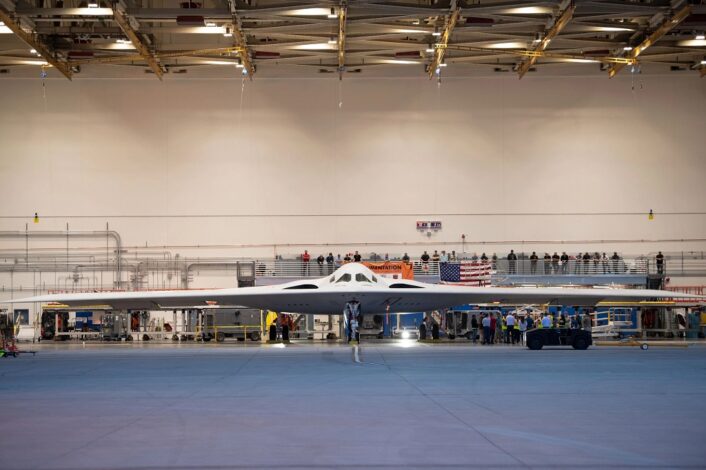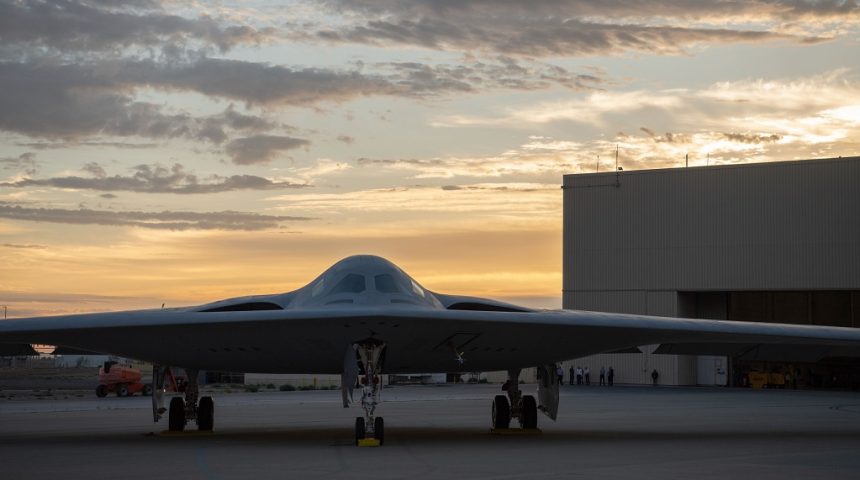During last week’s Air, Space and Cyber Conference, the Air Force provided a public update on the next-gen bomber.
As we reported in detail last week, during the 2023 Air, Space & Cyber Conference, the Air Force provided an update on the status of the B-21 Raider stealth bomber, together with some new photos of the next-gen aircraft. Northrop Grumman has just released yet another new photo and a recap of the discussion about the effective program management, production readiness and early integration of sustainment elements as foundational to the effective delivery of operational capability.
We already saw from the photos that the bomber is now in a much more advanced state of completion, compared to the day of the official rollout. Gen. Thomas A. Bussiere, Commander of the Air Force Global Strike Command, also provided an update on the tests, mentioning that engine runs are currently in progress at Northrop Grumman’s facilities at Air Force Plant 42 in Palmdale, with the first flight expected by the end of calendar year 2023.
In the new details released, it was stressed again that the first B-21 Raider test article has been built with rigorous production processes on the same manufacturing line with equal tooling that will be utilized to continue shaping the B-21 fleet. In fact, as a risk reduction and increased efficiency measure, a key to the overall program strategy established from the outset was to build a production representative first test article, rather than a proper prototype followed by series aircraft.
“The B-21 program is a prime example of how industry can be a capable partner in providing systems that meet critical needs, efficiently. The first test aircraft was built by our technicians using factory production processes; we’re doing that learning and refining in parallel, which will enable us to get to stable and steady production more quickly,” said Tom Jones, sector president for Northrop Grumman Aeronautics Systems.
The decision to build a highly representative test vehicle will allow Northrop Grumman and the Air Force to conduct a robust flight test campaign. The aircraft will then need minimal work to assume the final operational configuration before joining a squadron, something that could not be done with a “classic” test aircraft.

During the initial development phase, the design team was already looking at the long-term and took sustainment into account, instead of focusing just on production in the early stages of the program. This decision improved the efficiency in the long term, while also providing unspecified near-term benefits, most probably referring to the preparation for the operational fielding of the aircraft both on the logistics and training sides.
“Given Northrop Grumman’s focus on sustainment early in development, the B-21 is much further along on tech data than we would typically expect on a new program at this point,” said Doug Young, vice president and division general manager, Northrop Grumman Aeronautics Systems. “Development of content such as product support, materiel readiness and training is well underway, giving B-21 a head start on support and sustainment operations ahead of delivery to the user community.”
In line with the most recent developments of the aerospace industry, the B-21 Raider utilizes the latest in digital tools and capabilities from design to development and test, and ultimately in sustainment. Northrop Grumman says the focus on the B-21 digital ecosystem, coupled with investment in labs and testing facilities, has allowed the design team to digitally model B-21 performance prior to physical movements or needs.
In fact, advanced digital tools like digital twins, computational fluid dynamics (CFD) tools and simulation environments allow to test many aspects of the aircraft before even building it, allowing at the same time to check for design features that need changes. According to Northrop Grumman, the digital models being used are outperforming industry standards with twice the accuracy.
The effectiveness of these technologies is evident in initial testing with the first B-21 test article performing as expected during various ground tests. In fact, Northrop Grumman says testing of the engines, weapons bay doors, landing gear and control services demonstrated expected results and indicates the effectiveness and value of digital modeling.
As mentioned during the rollout, the B-21 Raider is the world’s first sixth-generation aircraft, backed by decades of expertise in stealth technology and optimized for the high-end threat environment. With its open architecture and application of cloud technology, the B-21 Raider is built for seamless incorporation of software upgrades and new capabilities.
The B-21 is designed with modular, open systems architecture to allow easy upgrades, in line with other new generation programs currently in the works. Northrop Grumman says it has already demonstrated the B-21 will be capable of integrating third party technology, supporting the program’s utmost focus on modernization and need to keep the weapon system on the leading edge of future threats.









